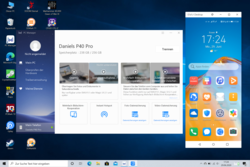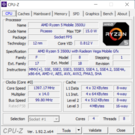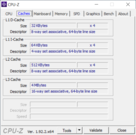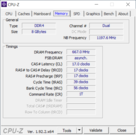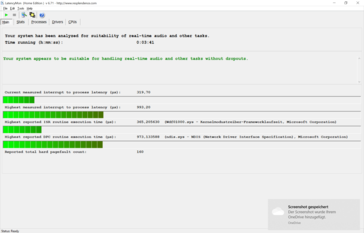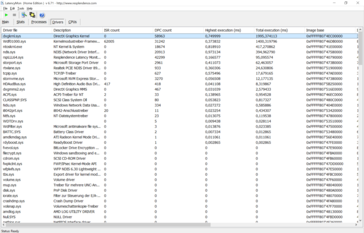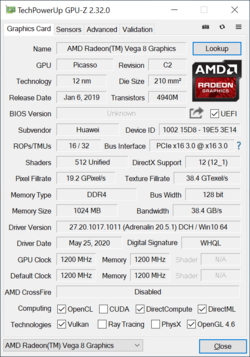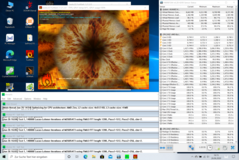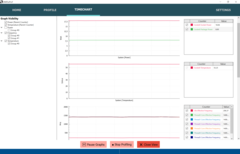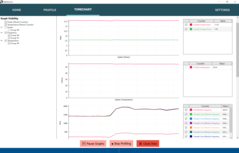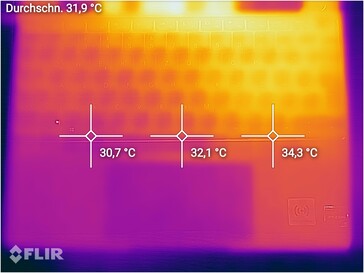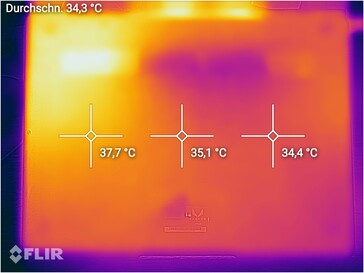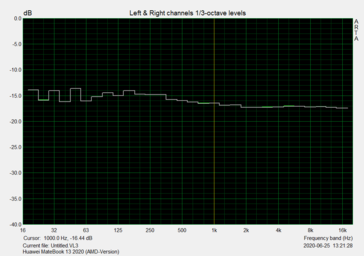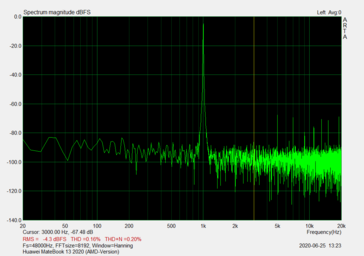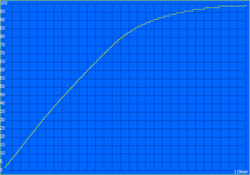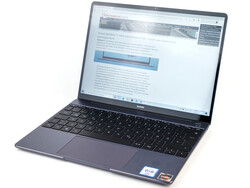Huawei MateBook 13 (2020) review - A Ryzen laptop isn't always the better choice
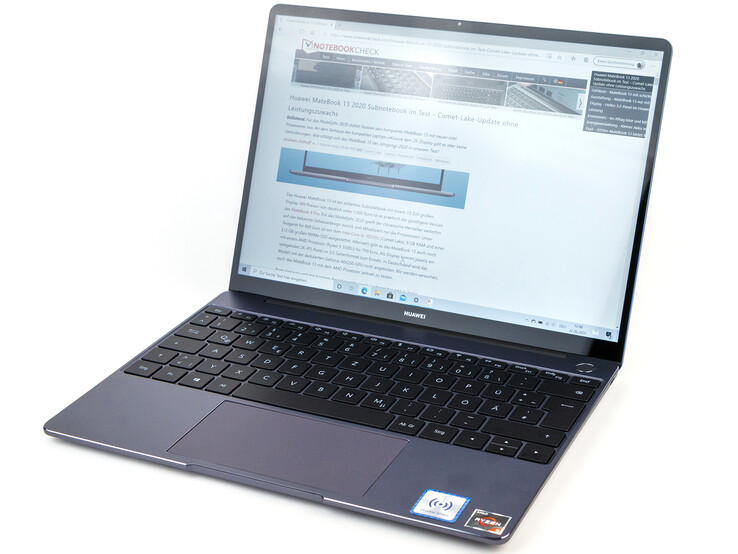
We already reviewed the Intel version of this year's MateBook 13 from Huawei; now the AMD Ryzen variant has to prove itself as well. The two models are very similar on the data sheet, but the AMD version has the faster RAM and, according to the manufacturer, shorter battery life.
Due to the similarities with the Intel model, we won't go into the sections regarding the case, connectivity, display and speakers in this review, but we will focus on the differing aspects instead. These turned out to be greater than we would have expected.
One big advantage of the AMD laptop is already certain: It's cheaper than the Intel model. If 256 GB of NVMe storage is enough for you, then you can get this configuration for 749 Euros (~$843); the model with 512 GB costs 799 Euros (~$899).
Rating | Date | Model | Weight | Height | Size | Resolution | Price |
|---|---|---|---|---|---|---|---|
| 84 % v7 (old) | 07 / 2020 | Huawei MateBook 13 2020 AMD R5 3500U, Vega 8 | 1.3 kg | 14.9 mm | 13.00" | 2160x1440 | |
| 84.4 % v7 (old) | 06 / 2020 | Huawei MateBook 13 2020 i5 i5-10210U, UHD Graphics 620 | 1.3 kg | 14.9 mm | 13.00" | 2160x1440 | |
| 88 % v7 (old) | 04 / 2020 | Apple MacBook Air 2020 i5 i5-1030NG7, Iris Plus Graphics G7 (Ice Lake 64 EU) | 1.3 kg | 16.1 mm | 13.30" | 2560x1600 | |
| 88.8 % v7 (old) | 03 / 2020 | Dell XPS 13 9300 i5 FHD i5-1035G1, UHD Graphics G1 (Ice Lake 32 EU) | 1.2 kg | 14.8 mm | 13.40" | 1920x1200 | |
| 85.9 % v7 (old) | 06 / 2020 | Acer Swift 3 SF313-52-52AS i5-1035G4, Iris Plus Graphics G4 (Ice Lake 48 EU) | 1.2 kg | 16.6 mm | 13.50" | 2256x1504 |
Communication - Wi-Fi 5 and Huawei Share in the MateBook 13
With the Realtek 8822CE, the MateBook 13 (2020) has a Wi-Fi 5 WLAN module that works in both 2.4 and 5.0 GHz networks. Thanks to the integrated MIMO antenna technology, the AMD version of the MateBook also achieves similar transfer speeds to our Netgear Nighthawk AX12 reference router as the Intel model. Since Huawei only uses VHT80, the transfer rates are significantly lower than those of the competitors with Wi-Fi 6. The range is convincing in the test and is at an identical level as the i5 version that we reviewed.
One practical feature is Huawei Share, which is compatible with Huawei smartphones starting from EMUI 8.0 or with Honor smartphones starting from Magic UI 2.1. As a result, the respective mobile phone can be effortlessly coupled with the laptop via NFC or through a search process and be easily used as a hotspot for the laptop; the established WLAN can also be used to quickly back up photos and videos. Starting from EMUI 9.1, any kind of data can be exchanged (OneHop), which was no problem with the Huawei P10 in our test. Smartphones with the latest OS version, EMUI 10.1, have the greatest range of features; in this way, among other things, the cache of the connected devices can be synchronized to allow multi-screen collaboration, in which the smartphone is controlled in windowed mode on the laptop and data can be exchanged easily via drag-and-drop.
Processor - AMD Ryzen 5 3500U
With the Ryzen 5 3500U, the Huawei MateBook 13 (2020) doesn't have the latest generation of AMD processors, but this is primarily due to the fact that this laptop model came very late to Germany and was still up-to-date at the global launch.
Nevertheless, the user gets a powerful performance package. The quad-core chip has a 12 nm structural width and can process up to eight threads simultaneously. The CPU has a nominal clock speed between 2,100 and 3,700 MHz. The system is aided by 8 GB of LPDDR4 memory, which runs at 2,400 MHz and is, therefore, newer and faster than the RAM in the Intel model (LPDDR3 @2,133 MHz) of the MateBook 13.
Consequently, the clock rates can be very high, but the full 3.7 GHz is only possible with two cores running at the same time under full load; the other two cores only reach 3.3 GHz in this case and only for a short time. The cooling system quickly kicks in then and the clock speed is reduced to around 2.4 GHz. The performance is not reduced on battery power.
As a result, the single-core performance drops back a bit in comparison to the Intel counterpart, and the two models also lie quite close together in the Cinebench R15 multi-core test. But the AMD model is ahead in terms of long-term performance stability since it delivers a performance increase of about 10% and is a bit faster in comparison to the EliteBook 735, which is based on the same components.
Cinebench R15: CPU Single 64Bit | CPU Multi 64Bit
Blender: v2.79 BMW27 CPU
7-Zip 18.03: 7z b 4 -mmt1 | 7z b 4
Geekbench 5.5: Single-Core | Multi-Core
HWBOT x265 Benchmark v2.2: 4k Preset
LibreOffice : 20 Documents To PDF
R Benchmark 2.5: Overall mean
| Cinebench R20 / CPU (Single Core) | |
| Average of class Subnotebook (128 - 826, n=70, last 2 years) | |
| Dell XPS 13 9300 i5 FHD | |
| Huawei MateBook 13 2020 i5 | |
| Apple MacBook Air 2020 i5 | |
| Apple MacBook Air 2020 i5 | |
| Huawei MateBook 13 2020 AMD | |
| Acer Swift 3 SF313-52-52AS | |
| Acer Swift 3 SF313-52-52AS | |
| HP EliteBook 735 G6 7KN29EA | |
| Average AMD Ryzen 5 3500U (317 - 372, n=15) | |
| Cinebench R20 / CPU (Multi Core) | |
| Average of class Subnotebook (579 - 8541, n=70, last 2 years) | |
| Dell XPS 13 9300 i5 FHD | |
| Average AMD Ryzen 5 3500U (1063 - 1540, n=15) | |
| Huawei MateBook 13 2020 AMD | |
| HP EliteBook 735 G6 7KN29EA | |
| Huawei MateBook 13 2020 i5 | |
| Apple MacBook Air 2020 i5 | |
| Apple MacBook Air 2020 i5 | |
| Acer Swift 3 SF313-52-52AS | |
| Acer Swift 3 SF313-52-52AS | |
| Cinebench R15 / CPU Single 64Bit | |
| Average of class Subnotebook (72.4 - 322, n=70, last 2 years) | |
| Huawei MateBook 13 2020 i5 | |
| Dell XPS 13 9300 i5 FHD | |
| Acer Swift 3 SF313-52-52AS | |
| Huawei MateBook 13 2020 AMD | |
| Average AMD Ryzen 5 3500U (131 - 147, n=18) | |
| Apple MacBook Air 2020 i5 | |
| HP EliteBook 735 G6 7KN29EA | |
| Cinebench R15 / CPU Multi 64Bit | |
| Average of class Subnotebook (327 - 3345, n=70, last 2 years) | |
| Dell XPS 13 9300 i5 FHD | |
| Dell XPS 13 9300 i5 FHD | |
| Huawei MateBook 13 2020 i5 | |
| Huawei MateBook 13 2020 AMD | |
| Average AMD Ryzen 5 3500U (482 - 682, n=19) | |
| HP EliteBook 735 G6 7KN29EA | |
| Acer Swift 3 SF313-52-52AS | |
| Apple MacBook Air 2020 i5 | |
| Blender / v2.79 BMW27 CPU | |
| Apple MacBook Air 2020 i5 | |
| Acer Swift 3 SF313-52-52AS | |
| Acer Swift 3 SF313-52-52AS | |
| Huawei MateBook 13 2020 i5 | |
| HP EliteBook 735 G6 7KN29EA | |
| Huawei MateBook 13 2020 AMD | |
| Dell XPS 13 9300 i5 FHD | |
| Average AMD Ryzen 5 3500U (680 - 796, n=10) | |
| Average of class Subnotebook (159 - 2271, n=73, last 2 years) | |
| 7-Zip 18.03 / 7z b 4 -mmt1 | |
| Average of class Subnotebook (2643 - 6442, n=72, last 2 years) | |
| Huawei MateBook 13 2020 i5 | |
| Dell XPS 13 9300 i5 FHD | |
| Acer Swift 3 SF313-52-52AS | |
| Acer Swift 3 SF313-52-52AS | |
| Average AMD Ryzen 5 3500U (3502 - 3580, n=10) | |
| Huawei MateBook 13 2020 AMD | |
| Apple MacBook Air 2020 i5 | |
| HP EliteBook 735 G6 7KN29EA | |
| 7-Zip 18.03 / 7z b 4 | |
| Average of class Subnotebook (11668 - 77867, n=70, last 2 years) | |
| Dell XPS 13 9300 i5 FHD | |
| Average AMD Ryzen 5 3500U (15825 - 17508, n=10) | |
| Huawei MateBook 13 2020 i5 | |
| HP EliteBook 735 G6 7KN29EA | |
| Huawei MateBook 13 2020 AMD | |
| Acer Swift 3 SF313-52-52AS | |
| Acer Swift 3 SF313-52-52AS | |
| Apple MacBook Air 2020 i5 | |
| Geekbench 5.5 / Single-Core | |
| Average of class Subnotebook (726 - 2350, n=65, last 2 years) | |
| Dell XPS 13 9300 i5 FHD | |
| Apple MacBook Air 2020 i5 | |
| Apple MacBook Air 2020 i5 | |
| Huawei MateBook 13 2020 i5 | |
| Acer Swift 3 SF313-52-52AS | |
| Acer Swift 3 SF313-52-52AS | |
| Huawei MateBook 13 2020 AMD | |
| Average AMD Ryzen 5 3500U (777 - 909, n=9) | |
| HP EliteBook 735 G6 7KN29EA | |
| Geekbench 5.5 / Multi-Core | |
| Average of class Subnotebook (2557 - 17218, n=65, last 2 years) | |
| Dell XPS 13 9300 i5 FHD | |
| Huawei MateBook 13 2020 i5 | |
| Acer Swift 3 SF313-52-52AS | |
| Acer Swift 3 SF313-52-52AS | |
| Average AMD Ryzen 5 3500U (2543 - 3269, n=9) | |
| Huawei MateBook 13 2020 AMD | |
| Apple MacBook Air 2020 i5 | |
| Apple MacBook Air 2020 i5 | |
| HP EliteBook 735 G6 7KN29EA | |
| HWBOT x265 Benchmark v2.2 / 4k Preset | |
| Average of class Subnotebook (0.97 - 25.1, n=70, last 2 years) | |
| Huawei MateBook 13 2020 i5 | |
| Dell XPS 13 9300 i5 FHD | |
| Average AMD Ryzen 5 3500U (3.35 - 4.15, n=10) | |
| Acer Swift 3 SF313-52-52AS | |
| Acer Swift 3 SF313-52-52AS | |
| HP EliteBook 735 G6 7KN29EA | |
| Huawei MateBook 13 2020 AMD | |
| Apple MacBook Air 2020 i5 | |
| LibreOffice / 20 Documents To PDF | |
| HP EliteBook 735 G6 7KN29EA | |
| Apple MacBook Air 2020 i5 | |
| Huawei MateBook 13 2020 AMD | |
| Average AMD Ryzen 5 3500U (81.9 - 91.4, n=3) | |
| Acer Swift 3 SF313-52-52AS | |
| Acer Swift 3 SF313-52-52AS | |
| Huawei MateBook 13 2020 i5 | |
| Average of class Subnotebook (38.5 - 220, n=69, last 2 years) | |
| R Benchmark 2.5 / Overall mean | |
| Apple MacBook Air 2020 i5 | |
| Apple MacBook Air 2020 i5 | |
| Acer Swift 3 SF313-52-52AS | |
| Acer Swift 3 SF313-52-52AS | |
| Huawei MateBook 13 2020 AMD | |
| HP EliteBook 735 G6 7KN29EA | |
| Average AMD Ryzen 5 3500U (0.734 - 0.804, n=8) | |
| Dell XPS 13 9300 i5 FHD | |
| Huawei MateBook 13 2020 i5 | |
| Average of class Subnotebook (0.403 - 1.456, n=71, last 2 years) | |
* ... smaller is better
System performance
In everyday use, the Huawei MateBook 13 (2020) also convinces with the AMD chipset delivering a smooth system performance on Windows 10. With its strong quad-core CPU and fast NVMe storage, the Huawei laptop is optimally equipped for most tasks even if the i5 model is faster in PCMark 8 and in the Essentials test of PCMark 10; this is probably due to the better performance rates of the SSD.
| PCMark 8 Home Score Accelerated v2 | 3846 points | |
| PCMark 8 Creative Score Accelerated v2 | 4845 points | |
| PCMark 8 Work Score Accelerated v2 | 4436 points | |
| PCMark 10 Score | 3861 points | |
Help | ||
| DPC Latencies / LatencyMon - interrupt to process latency (max), Web, Youtube, Prime95 | |
| Apple MacBook Air 2020 i5 | |
| Acer Swift 3 SF313-52-52AS | |
| HP EliteBook 735 G6 7KN29EA | |
| Dell XPS 13 9300 i5 FHD | |
| Huawei MateBook 13 2020 i5 | |
| Huawei MateBook 13 2020 AMD | |
* ... smaller is better
Storage
Nominally, all laptops in the MateBook 13 series feature the same 512 GB SSDs from WDC, which offer high speeds in all areas. However, the storage device performs worse in the AMD version and is sometimes considerably slower. This can be attributed to either a weaker memory controller or a mediocre driver implementation.
The somewhat peculiar partitioning of the NVMe memory, which results in a comparatively small system partition, is also found again in this Huawei laptop model. We recommend redistributing it directly in the system settings or to straight out delete the data partition (D drive).
| Huawei MateBook 13 2020 AMD WDC PC SN730 SDBPNTY-512G | Huawei MateBook 13 2020 i5 WDC PC SN730 SDBPNTY-512G | Apple MacBook Air 2020 i5 Apple SSD AP0512 | Dell XPS 13 9300 i5 FHD Toshiba XG6 KXG60ZNV512G | Acer Swift 3 SF313-52-52AS SK Hynix BC501 HFM512GDJTNG | Average WDC PC SN730 SDBPNTY-512G | |
|---|---|---|---|---|---|---|
| CrystalDiskMark 5.2 / 6 | 18% | 15% | -10% | 33% | ||
| Write 4K (MB/s) | 143.9 | 190.5 32% | 121.9 -15% | 120.6 -16% | 164.3 ? 14% | |
| Read 4K (MB/s) | 45.91 | 53.7 17% | 50 9% | 46.88 2% | 48.2 ? 5% | |
| Write Seq (MB/s) | 1307 | 1436 10% | 1497 15% | 1044 -20% | 2096 ? 60% | |
| Read Seq (MB/s) | 1435 | 1356 -6% | 2111 47% | 1147 -20% | 2123 ? 48% | |
| Write 4K Q32T1 (MB/s) | 237.1 | 382.5 61% | 365.9 54% | 332.4 40% | 451 ? 90% | |
| Read 4K Q32T1 (MB/s) | 332.7 | 502 51% | 384.6 16% | 443.3 33% | 509 ? 53% | |
| Write Seq Q32T1 (MB/s) | 2698 | 2114 -22% | 2748 2% | 1052 -61% | 2551 ? -5% | |
| Read Seq Q32T1 (MB/s) | 3394 | 3410 0% | 3119 -8% | 2171 -36% | 3330 ? -2% | |
| AS SSD | 65% | -64% | -9% | -25% | 39% | |
| Seq Read (MB/s) | 2844 | 2912 2% | 1153 -59% | 2328 -18% | 1370 -52% | 2605 ? -8% |
| Seq Write (MB/s) | 2316 | 2190 -5% | 1367 -41% | 1137 -51% | 1019 -56% | 1905 ? -18% |
| 4K Read (MB/s) | 40.76 | 49.52 21% | 12.95 -68% | 48.07 18% | 50.8 25% | 45.8 ? 12% |
| 4K Write (MB/s) | 96.9 | 167.1 72% | 24.52 -75% | 120.6 24% | 111.2 15% | 155.6 ? 61% |
| 4K-64 Read (MB/s) | 1275 | 1447 13% | 665 -48% | 899 -29% | 770 -40% | 1181 ? -7% |
| 4K-64 Write (MB/s) | 1156 | 1513 31% | 159.5 -86% | 1220 6% | 713 -38% | 1372 ? 19% |
| Access Time Read * (ms) | 0.074 | 0.05 32% | 0.295 -299% | 0.085 -15% | 0.0801 ? -8% | |
| Access Time Write * (ms) | 0.039 | 0.023 41% | 0.163 -318% | 0.033 15% | 0.034 13% | 0.04195 ? -8% |
| Score Read (Points) | 1600 | 1787 12% | 793 -50% | 1180 -26% | 958 -40% | 1488 ? -7% |
| Score Write (Points) | 1485 | 1899 28% | 321 -78% | 1455 -2% | 926 -38% | 1718 ? 16% |
| Score Total (Points) | 3879 | 4569 18% | 1528 -61% | 3189 -18% | 2370 -39% | 3938 ? 2% |
| Copy ISO MB/s (MB/s) | 433.2 | 2290 429% | 1433 231% | 1718 ? 297% | ||
| Copy Program MB/s (MB/s) | 266.4 | 555 108% | 363 36% | 536 ? 101% | ||
| Copy Game MB/s (MB/s) | 620 | 1300 110% | 725 17% | 1193 ? 92% | ||
| Total Average (Program / Settings) | 42% /
48% | -64% /
-64% | 3% /
1% | -18% /
-18% | 36% /
37% |
* ... smaller is better
Continuous load read: DiskSpd Read Loop, Queue Depth 8
Graphics card - Performance drops despite iGPU
The graphics calculations are handled by the Picasso chipset's integrated AMD Radeon Vega 8 GPU, which uses 1 GB of RAM. The iGPU masters common everyday tasks such as playing high-resolution videos or simple graphics processing without any problems. It doesn't turn the MateBook 13 into a gaming PC either, but it is significantly more powerful than its sibling model with the Intel configuration, so that some titles can be played well at least at low details and reduced resolution. The difference is also very clear in the 3DMark benchmark, because the AMD MateBook is at least 80% faster, and Huawei also delivers a much stronger performance compared to the EliteBook.
In the gaming benchmarks, some games, such as Warhammer and F1 2k19, complained that there wasn't enough RAM available, but they could still be executed. Only Doom Eternal crashed at startup and completely took over the available RAM.
| 3DMark 11 Performance | 3619 points | |
| 3DMark Cloud Gate Standard Score | 13533 points | |
| 3DMark Fire Strike Score | 2142 points | |
| 3DMark Fire Strike Extreme Score | 979 points | |
| 3DMark Time Spy Score | 881 points | |
Help | ||
Gaming performance
| low | med. | high | ultra | |
|---|---|---|---|---|
| The Witcher 3 (2015) | 24.5 | 15.35 | ||
| Dota 2 Reborn (2015) | 70 | 63.2 | 38.9 | 34.6 |
| Warhammer 40.000: Dawn of War III (2017) | 42.69 | 17.95 | ||
| X-Plane 11.11 (2018) | 26.9 | 21 | 18.4 | |
| Far Cry 5 (2018) | 19 | 12 | ||
| F1 2019 (2019) | 46.2 | 27.6 | 24.2 | 22.5 |
Emissions - GPU makes quite some noise
Noise emissions
The MateBook 13 is practically inaudible during normal use. The fans remain silent while using office applications or browsing the web. As soon as the GPU is loaded, however, this changes quite quickly. While the two fans are only perceived as a quiet background buzz under moderate load, the noise level intensifies under full load.
However, if you raise the laptop's base a bit and give the air vents on the bottom more room, you'll reduce the noise level back down very quickly by a good 6 dB(A).
Noise level
| Idle |
| 27.2 / 27.2 / 27.2 dB(A) |
| Load |
| 31.8 / 38.3 dB(A) |
 | ||
30 dB silent 40 dB(A) audible 50 dB(A) loud |
||
min: | ||
Temperature
The Huawei MateBook 13 (2020) stays pleasantly cool on all sides in idle usage. In the stress test, the temperatures undergo a strong increase and concentrate themselves on the right area, but they remain significantly cooler than with the Intel model. However, we still don't recommend placing the laptop on bare skin in this case. The palm rest stays comparatively cool, and the surface temperatures don't have a negative impact when working with the laptop.
The processor's clock rate drops continuously in the stress test and falls below the base clock speed (throttling) after a few minutes, to then settle at a bit over 1.4 GHz. After the stress test, the system recovers very quickly, and an adverse effect on performance can't be determined afterwards.
Those who only push the processor to its limits have more computing power available because the Ryzen CPU then stabilizes at 2.4 GHz. When we disconnected the external power supply during the stress test, the CPU's clock speed increased again and stabilized at 1.85 GHz.
(+) The maximum temperature on the upper side is 39.3 °C / 103 F, compared to the average of 35.9 °C / 97 F, ranging from 21.4 to 59 °C for the class Subnotebook.
(±) The bottom heats up to a maximum of 40.2 °C / 104 F, compared to the average of 39.3 °C / 103 F
(+) In idle usage, the average temperature for the upper side is 28.5 °C / 83 F, compared to the device average of 30.8 °C / 87 F.
(+) The palmrests and touchpad are reaching skin temperature as a maximum (32.6 °C / 90.7 F) and are therefore not hot.
(-) The average temperature of the palmrest area of similar devices was 28.2 °C / 82.8 F (-4.4 °C / -7.9 F).
Audio jack
On the left side of the Huawei MateBook 13 there is a 3.5 mm audio jack that serves the laptop as a combined headphone output and microphone input connection. Subjectively, the port does its job well and provides a fairly noise-free reproduction.
However, the signal-to-noise ratio (SNR: 62.62 dBFS) is only satisfactory in our measurements, while the harmonic distortions are on a good level. As a result, the jack is certainly not designed for audiophiles but is perfectly sufficient for communication tasks or simple media playback.
Energy management - Shorter battery life is confirmed in the test
Energy consumption
The MateBook 13 needs a comparatively high amount of energy, especially in idle usage, but it's much more economic under load than its Intel counterpart; the same applies to the standby mode.
The peak load of 47.1 watts is already clearly below what the 65-watt power adapter is capable of; in addition, the consumption settles quite quickly at 43 watts. The modular power adapter is the same model that also comes with the Mate Xs and supports Huawei's SuperCharge at 55 watts.
| Off / Standby | |
| Idle | |
| Load |
|
Key:
min: | |
| Huawei MateBook 13 2020 AMD R5 3500U, Vega 8, WDC PC SN730 SDBPNTY-512G, IPS, 2160x1440, 13" | Huawei MateBook 13 2020 i5 i5-10210U, UHD Graphics 620, WDC PC SN730 SDBPNTY-512G, IPS, 2160x1440, 13" | Apple MacBook Air 2020 i5 i5-1030NG7, Iris Plus Graphics G7 (Ice Lake 64 EU), Apple SSD AP0512, IPS, 2560x1600, 13.3" | Dell XPS 13 9300 i5 FHD i5-1035G1, UHD Graphics G1 (Ice Lake 32 EU), Toshiba XG6 KXG60ZNV512G, IPS, 1920x1200, 13.4" | Acer Swift 3 SF313-52-52AS i5-1035G4, Iris Plus Graphics G4 (Ice Lake 48 EU), SK Hynix BC501 HFM512GDJTNG, IPS, 2256x1504, 13.5" | HP EliteBook 735 G6 7KN29EA R5 PRO 3500U, Vega 8, WDC PC SN520 SDAPNUW-256G, IPS LED, 1920x1080, 13.3" | Average AMD Radeon RX Vega 8 (Ryzen 2000/3000) | Average of class Subnotebook | |
|---|---|---|---|---|---|---|---|---|
| Power Consumption | -2% | 24% | 8% | 28% | -4% | -7% | -5% | |
| Idle Minimum * (Watt) | 4.71 | 2.97 37% | 2.4 49% | 3.4 28% | 3 36% | 5.6 -19% | 5.68 ? -21% | 4 ? 15% |
| Idle Average * (Watt) | 8.65 | 7.5 13% | 6.8 21% | 6 31% | 6.1 29% | 8.1 6% | 8.75 ? -1% | 6.85 ? 21% |
| Idle Maximum * (Watt) | 9.42 | 9.6 -2% | 10.5 -11% | 10.2 -8% | 8.4 11% | 9.6 -2% | 10.1 ? -7% | 8.47 ? 10% |
| Load Average * (Watt) | 34.23 | 38.9 -14% | 25.7 25% | 36.6 -7% | 25.7 25% | 34.3 -0% | 37.8 ? -10% | 44.4 ? -30% |
| Load Maximum * (Watt) | 47.1 | 66.7 -42% | 30.4 35% | 49.3 -5% | 27.6 41% | 48.6 -3% | 46.2 ? 2% | 67.4 ? -43% |
| Witcher 3 ultra * (Watt) | 24.5 |
* ... smaller is better
Battery life
The 41.7-watt-hour battery is quite small and offers the lowest capacity in the comparison field. Huawei itself states that the AMD model has shorter battery life than the Intel variant; depending on the usage scenario, it should be between one and four-and-a-half hours less. The highest difference is supposed to be observed with video reproduction (manufacturer: 11.6 h (Intel) vs. 7 h (AMD)), which we can't confirm. The difference between the two models is much smaller, and the test device even lasts longer than offered.
Things look different when surfing the web on WLAN (150 cd/m²). The MateBook 13 shows lower battery runtimes than Huawei states here, whereby the company doesn't give any information about the determination of the rates either. At 5 h 19 m, the value is alright, but we certainly can't speak of a brilliant performance here, especially since the i5 version squeezes more runtime out of the battery.
The 65-watt adapter doesn't even take two hours to fully recharge the battery.
| Huawei MateBook 13 2020 AMD R5 3500U, Vega 8, 41.7 Wh | Huawei MateBook 13 2020 i5 i5-10210U, UHD Graphics 620, 41.7 Wh | Apple MacBook Air 2020 i5 i5-1030NG7, Iris Plus Graphics G7 (Ice Lake 64 EU), 49.9 Wh | Dell XPS 13 9300 i5 FHD i5-1035G1, UHD Graphics G1 (Ice Lake 32 EU), 52 Wh | Acer Swift 3 SF313-52-52AS i5-1035G4, Iris Plus Graphics G4 (Ice Lake 48 EU), 54.5 Wh | HP EliteBook 735 G6 7KN29EA R5 PRO 3500U, Vega 8, 50 Wh | Average of class Subnotebook | |
|---|---|---|---|---|---|---|---|
| Battery runtime | 13% | 66% | 99% | 104% | 55% | 88% | |
| H.264 (h) | 8.8 | 9.7 10% | 10.7 22% | 14.4 64% | 16.7 ? 90% | ||
| WiFi v1.3 (h) | 5.3 | 7.4 40% | 10.3 94% | 11.7 121% | 10.8 104% | 8.2 55% | 13.3 ? 151% |
| Load (h) | 1.6 | 1.4 -12% | 2.9 81% | 3.4 113% | 1.945 ? 22% |
Pros
Cons
Verdict - The price has its price
With the Huawei MateBook 13, buyers get a really good subnotebook, even with an AMD chipset, which is, above all, comparatively inexpensive and already available from 749 Euros (~$842). The USB adapter included in the box is certainly rather a weak consolation for the omission of the MateDock 2.
The stronger iGPU of the Picasso chipset didn't have a big influence on the score, but it can mark the difference between a game that is still playable and one that looks like a flipbook, especially for casual gamers. We also see a slight advantage for the AMD version when using creative programs like Photoshop.
The MateBook 13 with the Ryzen chipset is cheaper, but users have to put up with tradeoffs, above all, in terms of battery life.
On the other hand, if you're on the road a lot and for a long time, you should think twice about not going for the Intel model, since it mostly scores noticeably better in terms of battery life. Whichever MateBook you choose, both chip variants are housed in a high-quality metal case, which has been equipped with decent input devices. Those who also own a halfway up-to-date Huawei smartphone will get a useful additional feature with Huawei Share.
Huawei MateBook 13 2020 AMD
- 06/29/2020 v7 (old)
Daniel Schmidt




